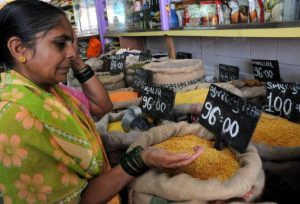 Prof. Raj Kishore Panda* in Bhubaneswar, October 17, 2022: The Indian Economy is presently facing a high rate of inflation. Based on Consumer Price Index the inflation rate is worked out to 7.4 percent in September, 2022 – above the tolerance level (6 %) as is identified by the Reserve Bank of India.
Prof. Raj Kishore Panda* in Bhubaneswar, October 17, 2022: The Indian Economy is presently facing a high rate of inflation. Based on Consumer Price Index the inflation rate is worked out to 7.4 percent in September, 2022 – above the tolerance level (6 %) as is identified by the Reserve Bank of India.
What is of concern that this high rate of retail inflation (above 6 percent) continuing over the last five months is certainly going to influence the recovery and growth of the economy adversely affected by the Covid-19 pandemic. Apprehending the present inflationary situation to continue in near future the IMF has revised its estimated GDP growth rate of the Indian economy from 7.4 per cent to 6.8 percent for the fiscal year 2022-23.
Assessing the situation from time to time the Reserve Bank of India has raised the repo rate (the policy rate at which the central bank lends to commercial banks) four times (190 basis point) since May this year. The repo rate has gone up from 4 percent to 5.90 percent. The very purpose of raising repo rate is to drain out surplus money from circulation which will reduce spending and encourage savings by the people. However, the RBI has not been successful in reining inflation in the country. This has raised questions on the efficacy of raising repo rate as a monetary policy instrument by the RBI in controlling the inflation.
Before we speak on effectiveness of the repo rate in controlling Inflation it is of importance to know about the way the inflation rate is calculated in India as this significantly influences the RBI’s policy rate in tackling the problem. Broadly there are two ways of measuring rate of inflation- (i) on the Wholesale Price Index (WPI) and (ii) on the Consumer Price Index (CPI). While the former tracks the changes in price level at the wholesale level/ producer’s level, the CPI captures changes in price level at the consumer level. Earlier RBI used to follow WPI measure.
However, from 2014 it has replaced CPI as a measure to calculate inflation rate. What is interesting to point out here that there is always a gap between rate of inflation based on Wholesale Price Index and Consumer Price Index. Though both the measures are of importance from the total view of the goods and services traded in the economy, yet the gap between the two causes problem for the Reserve Bank to adopt strategy in targeting inflation. As per latest available data at present while WPI inflation shows a fluctuating trend, the CPI inflation continues to surge.
 Inflation writes Friedman is a monetary phenomenon. As such price stability is understood in terms of monetary stability. Since the Central Bank of a country is the sole supplier of money it is primarily assigned the task of maintaining price stability by controlling the money supply in the country. However, researchers are divided on the effectiveness of monetary policy in controlling inflation and this is largely based on divergence in their empirical findings in both developed and developing countries.
Inflation writes Friedman is a monetary phenomenon. As such price stability is understood in terms of monetary stability. Since the Central Bank of a country is the sole supplier of money it is primarily assigned the task of maintaining price stability by controlling the money supply in the country. However, researchers are divided on the effectiveness of monetary policy in controlling inflation and this is largely based on divergence in their empirical findings in both developed and developing countries.
More so in relation to developing countries these studies show that while repo rate is effective in controlling inflation, it is found to be ineffective in stimulating economic growth. Thus, in the Indian context there is the dilemma before the RBI – how to synchronize both these objectives – controlling inflation and achieving higher growth. As we see so far the RBI has followed an accommodative policy. While raising the first repo rate on 4th May the RBI has failed to read the impending danger.
Again, there is often debate that since inflation in India is largely driven by rise in food prices – a supply side phenomenon and it needs to be tackled by strengthening the supply side rather than containing demand side through interest rate hike. Strange to note that while during the pandemic the country witnessed sharp fall in GDP and employment, the revival of the economy in term of GDP growth would not have caused such a rise in inflation had there not been supply bottlenecks.
Along with domestic supply not rising fast to accommodate the demand, the breakdown in global supply chains and rising transport cost etc; added to current rise in price level in the country. However, since persistent high food prices impact core inflation, a hike in policy rate is needed though it leads to output loss. The Reserve Bank of India has to follow a cautious policy keeping rising prices and impending recession together.
By only raising repo rate to control inflation in the face of pro-inflationary government policy continuing to lift the economy would hamper the growth rate and investment patterns thus putting the economy into a vicious circle of rising nominal interest rates, rising inflation, economic stagnation and increasing debt.
- Formerly Professor of Economics, Utkal University & Director, Naba Krushna Choudury Centre for Development Studies, Odisha, Bhubaneswar


Leave a Reply
Be the First to Comment!